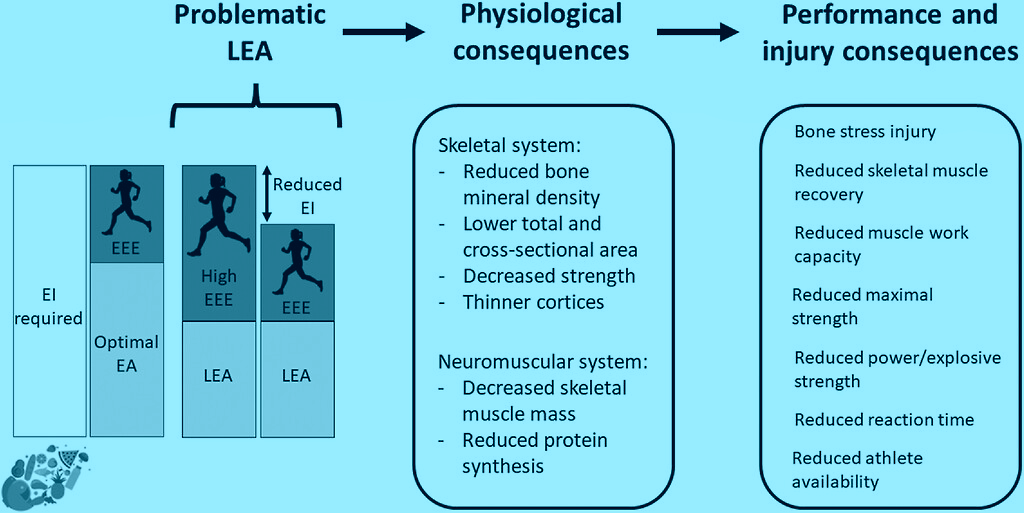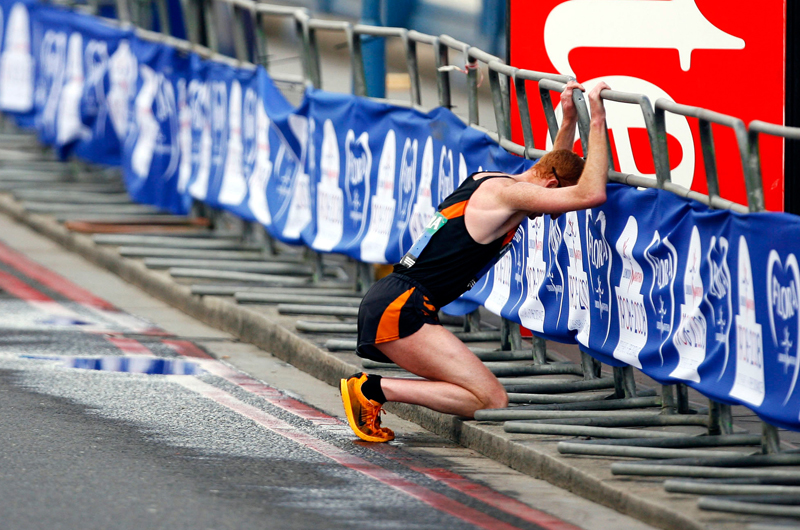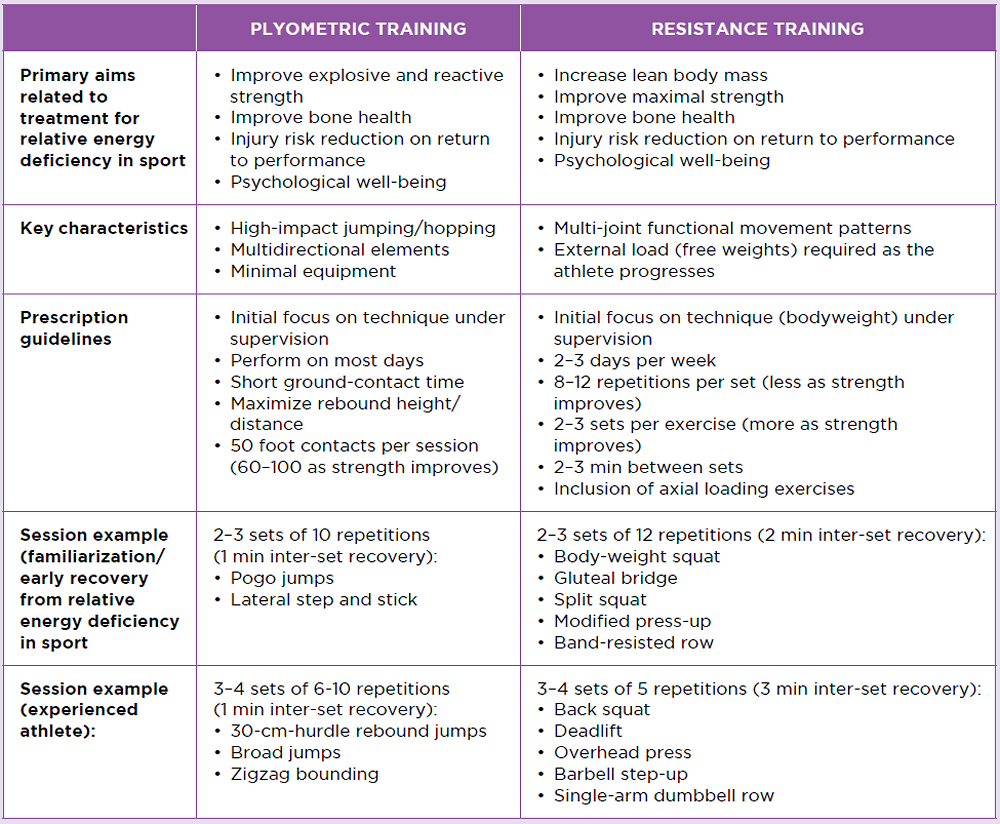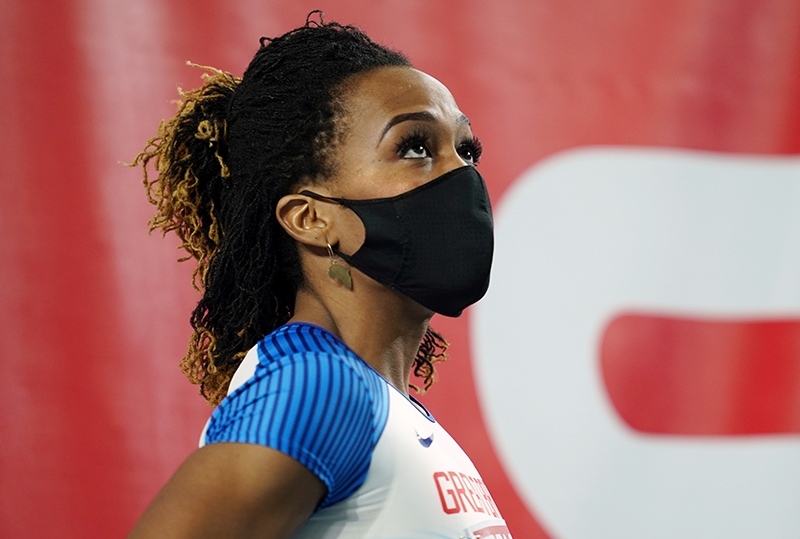You are viewing 1 of your 1 free articles. For unlimited access take a risk-free trial
Undernutrition: the strong road to recovery
Andrew Sheaff revisits the topic of energy deficiency in athletes, and looks at new research showing how athletes can use strength training to recover from the effects of undernutrition
In most sports, the body is moved through space, and being able to move the body through space with greater speed is almost always a performance advantage. This is particularly true in endurance sports where athletes must cover large distances in as little time as possible. Doing so depends on two factors: the ability to create large amounts of force and the ability to keep body mass as low as possible. The more force athletes can create over time, the faster they’ll go, and the less mass they have to move with that force, the faster they’ll go.
Training, nutrition and RED-S
To optimize performance, endurance athletes undertake large volumes of training to develop the physiological resources to produce large amounts of energy to power their efforts. The more energy they can create and sustain, they better their performances will be, and high training loads support the development of these abilities. At the same time, many athletes will attempt to work on the other side of the equation, controlling or limiting energy intake in the attempt to reduce body mass or maintain it at an optimally low level.
When energy expenditure significantly exceeds energy intake, athletes experience low energy availability. In other words, because they are expending a lot of energy through training, while consuming insufficient energy through their diet, they create a significant negative energy balance. Unfortunately, when low energy availability is present for extended periods of time, it can lead to many negative health and performance outcomes, which we’ll discuss shortly. These are collectively known as ‘Relative Energy Deficiency Syndrome’ or RED-S for short.
Of course, RED-S is not limited exclusively to endurance athletes. Any athlete with high exercise energy expenditures due to a high training volume is potentially at risk. Likewise, any athlete that is voluntarily entering a caloric deficit (to lose a significant amount of weight) is also at risk, regardless of their sport. And certainly, those risks go up when both factors are present. It’s all about energy balance and maintaining an optimal relationship between energy expenditure and energy intake. Whenever one or both sides of the equation significantly deviate from the norm, negative consequences can ensue. As such, it’s an issue that can impact any individual involved in sport. And with high training volumes and energy restricted diets present throughout sport, it does impact many individuals.
Unfortunately however, much of the focus remains on the positive benefits of high training volumes and energy restrictive diets, with little attention given to the risk of negative outcomes. While these strategies undoubtedly can be beneficial, failure to acknowledge the risks can lead to outcomes that are opposite of the intended ones. An understanding of the potential risks of RED-S, as well as strategies to combat the negative impacts of RED-S is critical for both long-term athlete health and long-term performance.
Understanding RED-S
As metabolic energy is critical for normal functioning of the body, whenever energy availability is low for extended periods of time, this can lead to multiple unwanted effects. Dysregulation of the hormone, metabolic, blood, psychological, growth and development, cardiovascular, immunological, gastrointestinal systems and more have shown to be negatively affected by RED-S(1). Unsurprisingly, metabolic energy is critical for the function of every cell in the body, and if there’s not enough of it to go around, there are going to be consequences in every bodily system!
Even if you’re the most die-hard athlete in the world, and the health concerns are of no consequence to you, RED-S should have your attention because numerous negative outcomes are directly associated performance. As figure 1 shows, these include decreased endurance performance, decreased muscle strength, decreased training response, decreased glycogen stores, decreased coordination, and more(1). Obviously, this is all bad news if you want to perform at your best!
In particular, RED-S can have many negative impacts on the musculoskeletal system(2). It can lead to reduced bone mineral density, total bone size, and thinner bones. This makes the bones less resilient to the repetitive loading present in sport, increasing the likelihood of bone stress injuries or even fractures. These are injuries that can quickly sideline athletes for extended periods of time.
When it comes to the muscles themselves, RED-S invariably induces losses in muscle strength, power, and explosive strength. This is significant as speed is a relevant factor in almost every sport. Losses in muscle function will have a direct negative impact on performance. Beyond the direct impact on performance, reduced muscle recovery and reduce muscle work capacity are often present as well. This leads to poorer training performance or poorer recovery from that training, resulting in stalled progression during training.
Figure 1: Physiological consequences and potential performance/injury implications of RED-S(2)
Related Files

Recovery from RED-S
Either due to a lack of awareness, miscalculations in training load and nutrition intake, or the inability to take a more conservative approach, athletes can find themselves suffering from RED-S, and needing to take steps to recover. The most obvious course of action is restoration of optimal energy availability through reduced training loads and increased energy intake. Once optimal energy availability is restored, it’s a matter of time and patience, allowing the negative effects of impaired energy availability to be reversed.
For the motivated athlete however, this can be more challenging than training hard! Fortunately, there are steps that athletes can take to accelerate their recovery, particularly from a musculoskeletal perspective. As RED-S is associated with compromise of the musculoskeletal system, this compromise needs to be reversed, and a group of researchers have suggested that the most effective strategies for doing so are plyometric training and resistance training(2).
By including this work, athletes can restore their bone health, their maximal strength, and their ability to produce force quickly. Patient and progressive loading of the bones and muscles will build their strength and resilience. This will reduce the risk of injury as they return to full training and performance. Just as importantly, it gives athletes something they can do and be successful with, enhancing their psychological well-being and outlook.
Effective interventions
Plyometric and strength training interventions are particularly effective because they target bodily systems that are both influential on performance, and are negatively impacted by RED-S, and which put athletes at risk for future injuries. Furthermore, this type of training expends a relatively small number of calories, allowing for its inclusion while athletes are trying to stay in positive energy balance.
When implementing plyometric and strength training program with athletes recovering from RED-S, it’s critical to start very conservatively. The authors of the paper suggest starting with as little as 30 jumps/contacts when introducing plyometrics. This work can be done almost every day, patiently progressively to 100 contacts in sets of 6-10 repetitions. The difficult of the exercises can progress over time as well. They suggest that it’s important to progress to high-impact exercises to fully stress the bone. The inclusion of multidirectional movements meanwhile can help to positively stress the bones in multiple directions.
From a strength training perspective, body weight strength exercises can be a safe and effective initial stimulus. Over time, free weights and traditional strength training exercises should be included. As strength improves, the number of sets can be increased, the number of repetitions decreased, and the loads increased to provide a continued stimulus for adaptation. Of particular importance is the inclusion of spinal loading to ensure that the bones of the spine are strengthened over time.
While plyometric and resistance training can be useful for facilitating the recovery of the musculoskeletal system following RED-S, the same approach is likely to be beneficial in reducing the likelihood of experiencing a negative impact on bone and muscle health in the first place. Of course, the primary strategy for preventing RED-S is the maintenance of optimal energy availability through appropriate management of energy expenditure and energy intake. To further safeguard against any negative impacts of intentional or unintentional decreases in energy availability, plyometric and resistance training can ensure that the bones and muscles are optimally healthy.
Practical applications for athletes
First and foremost, recovery from and prevention of RED-S comes down to energy availability. Managing training loads and consuming sufficient calories to ensure optimal energy availability is the most important step in the process. There are no tricks or hacks that can circumvent this reality. However, when it comes to the health and performance potential of the musculoskeletal system, much can be done to ensure that these systems are functioning optimally.
If one does experience RED-S, part of the recovery process should include a progressive plyometric and resistance training program. Doing so will serve to re-establish the strength and function of the bones and muscles over time, which have been significantly compromised due to low energy availability. When done patiently, conservatively, and progressively, this process will be faster and more effective than passive rest of low levels of endurance training. For those looking to prevent the negative musculoskeletal outcomes associated with RED-S, the same strategies can be used to maintain optimal musculoskeletal health. Table 1 provides some practical guidelines for the use of plyometric and resistance training (as recommended by the authors of this new research paper) during return to performance following relative energy deficiency in sport.
Table 1: Practical guidelines for use of plyometric and resistance training(2)
References
1. British Journal of Sports Medicine 2014;48:491-497.
2. Int J Sports Physiol Perform. 2024 Jun 4;19(7):623-628. doi: 10.1123/ijspp.2023-0532. Print 2024 Jul 1.
Newsletter Sign Up
Testimonials
Dr. Alexandra Fandetti-Robin, Back & Body Chiropractic
Elspeth Cowell MSCh DpodM SRCh HCPC reg
William Hunter, Nuffield Health
Newsletter Sign Up
Coaches Testimonials
Dr. Alexandra Fandetti-Robin, Back & Body Chiropractic
Elspeth Cowell MSCh DpodM SRCh HCPC reg
William Hunter, Nuffield Health
Keep up with latest sports science research and apply it to maximize performance
Today you have the chance to join a group of athletes, and sports coaches/trainers who all have something special in common...
They use the latest research to improve performance for themselves and their clients - both athletes and sports teams - with help from global specialists in the fields of sports science, sports medicine and sports psychology.
They do this by reading Sports Performance Bulletin, an easy-to-digest but serious-minded journal dedicated to high performance sports. SPB offers a wealth of information and insight into the latest research, in an easily-accessible and understood format, along with a wealth of practical recommendations.
*includes 3 coaching manuals
Get Inspired
All the latest techniques and approaches
Sports Performance Bulletin helps dedicated endurance athletes improve their performance. Sense-checking the latest sports science research, and sourcing evidence and case studies to support findings, Sports Performance Bulletin turns proven insights into easily digestible practical advice. Supporting athletes, coaches and professionals who wish to ensure their guidance and programmes are kept right up to date and based on credible science.












